
Magento 2 Product Comparison: Setup & Optimization
Want to help your customers make informed purchase decisions?
Magento 2 product comparison lets shoppers evaluate multiple items without page reloads. You can configure this tool to display product attributes, prices, and specifications in an organized manner.
This article will explore the steps to install and optimize Magento product comparison.
Key Takeaways
-
Magento 2 makes product comparison simple and user-friendly for shoppers.
-
Comparison pages boost SEO with unique content and structured data.
-
Extensions enable features like responsive design and smart comparisons.
-
Security tips protect comparison data and enable smooth functionality.
-
Troubleshooting the compare product feature fixes common setup issues.
-
Security Considerations for Setting Up Magento 2 Product Comparison
-
3-Step Guide to Install & Configure Magento 2 Product Comparison Extension
-
Common Magento 2 Product Comparison Errors and Resolution Steps
What is Magento 2 Product Comparison?
“Magento 2 product comparison is a built-in feature. It lets shoppers compare multiple items side-by-side. The function displays product attributes, prices, and features in a comparison table.“
Customers can add products to compare from category pages or product pages. The comparison table shows up to 4 products by default.
The compare product feature works automatically in Magento Open Source. Alternatively, you can set up custom extensions that enable smart multiple product comparisons. Store owners can customize the comparison template and style. Mobile users get a responsive comparison view for easy shopping.
Impact of Magento 2 Product Comparison on SERP Rankings
1. Meta Data Optimization
-
Product comparison pages generate unique meta descriptions and titles. Each comparison page creates distinct content that search engines value for indexing.
-
Comparison tables produce structured data markup. Search engines can better understand and display product relationships in search results.
-
Dynamic meta tags update based on compared products. Fresh content signals help maintain search relevance.
-
URL structures remain clean and keyword-rich. Proper URL formatting improves crawlability and indexing.
2. Content Quality Signals
-
Side-by-side product comparisons create unique content combinations. Each comparison page shows unique information.
-
Detailed attribute comparisons increase content depth. More comprehensive product information satisfies user intent.
-
User engagement metrics improve with comparison features. Longer page views signal valuable content to search engines.
-
Natural keyword variations emerge through product attributes. Broader keyword coverage increases ranking opportunities.
3. Technical SEO Benefits
-
Ajax-based comparisons reduce page load times. Faster loading speeds positively impact rankings.
-
Proper HTML structure maintains content hierarchy. Clear content organization helps search engine understanding.
-
Mobile-responsive comparison displays work across devices. Mobile-friendliness directly affects search rankings.
-
Schema markup highlights product relationships. Rich results can improve click-through rates.
4. User Experience Factors
-
Easy product comparison reduces bounce rates. Lower bounce rates signal content relevance to search engines.
-
Clear attribute organization increases time on site. Engaged users indicate valuable content.
-
Print-friendly views offer additional content access. Multiple content delivery methods improve accessibility.
-
Social sharing options expand content reach. Increased social signals can influence rankings.
5. Local SEO Impact
-
Regional pricing comparisons serve local searchers. Location-specific content improves local rankings.
-
Multi-language comparison support targets global users. International SEO benefits from localized comparisons.
-
Store availability data enhances local relevance. Location-based inventory helps local search visibility.
-
Customer reviews integrate with comparison data. User-generated content strengthens local authority.
Security Considerations for Setting Up Magento 2 Product Comparison
| Security Aspect | Implementation | Risk Prevention |
|---|---|---|
| Data Encryption | Use the AES-256 algorithm for sensitive comparison data. Encrypt data at rest and in transit to protect customer information. | Prevents unauthorized access to comparison data. Safeguards customer privacy and builds trust. |
| Session Validation | Implement strict session checks for comparison features. Validate user sessions on each comparison action. | Stops session hijacking attempts. Keeps user comparison data secure across sessions. |
| CAPTCHA Protection | Add CAPTCHA to comparison forms and actions. Use reCAPTCHA v3 for invisible protection. | Blocks automated comparison spam. Prevents bots from abusing comparison features. |
| Access Control | Set user role restrictions for comparison settings. Limit admin access to comparison configuration. | Prevents unauthorized changes to comparison features. Maintains integrity of comparison functionality. |
| CSRF Protection | Add unique tokens to compare URLs and forms. Validate tokens on the server side for each request. | Stops cross-site request forgery (CSRF) attacks. Confirms that the comparison actions come from legitimate users. |
| Firewall Settings | Configure Web Application Firewall (WAF) rules for comparison endpoints. Set rate limits and block suspicious patterns. | Blocks malicious requests. Protects against DDoS attacks on comparison features. |
| SSL Configuration | Use HTTPS for all pages with comparison functionality. Implement HSTS for added security. | Secures data transmission during comparisons. Prevents man-in-the-middle attacks on comparison data. |
| Password Policies | Enforce strong passwords for admin access to comparison settings. Implement a 90-day password rotation policy. | Protects admin accounts from unauthorized access. Reduces risk of compromised comparison settings. |
3-Step Guide to Install & Configure Magento 2 Product Comparison Extension
Step 1: Installing the Extension
Method I: Manual Installation
-
Unzip the
[extension_name]_ajaxcompare-x.x.x.zipfile to a local folder. -
Create the
[extension_name]folder in yourmagento_directory/app/code/. If thecodefolder does not exist, create it. -
Create the
AjaxComparefolder inside[extension_name]. -
Copy all contents from the unzipped folder to the newly created
AjaxComparefolder. -
Open the console or shell and navigate to your Magento directory.
-
Run the following commands:
php bin/magento module:enable \[extension_name\]_AjaxCompare
php bin/magento setup:upgrade
php bin/magento setup:static-content:deploy \-f
chmod command for var/ pub/static and generated/ folders
- Reload the admin panel. You will find the extension on the left side of the menu.
Method II: Manual Installation
-
Unzip the
[extension_name]_ajaxcompare-x.x.x.zipfile to a local folder. -
Create the
[extension_name]folder in yourmagento_directory/app/code/. If thecodefolder does not exist, create it. -
Create the
AjaxComparefolder inside[extension_name]. -
Copy all contents from the unzipped folder to the newly created
AjaxComparefolder. -
Go to
your_magento_directory/app/etc/and open theconfig.phpfile. -
Add the following line to the
$modulesarray:'[extension_name]_AjaxCompare' => 1,. -
Open the console or shell and navigate to your Magento directory.
-
Run the following commands:
php bin/magento setup:upgrade
php bin/magento setup:static-content:deploy \-f
chmod command for var/ pub/static and generated/ folders
- Reload the Magento admin panel. You will now see the [extension_name] Extensions in the left side menu.
Step 2: Marketplace Installation Instructions
Extension purchased from the Magento Marketplace requires Composer-based installation.
-
Login to your account and go to the My Purchases page.
-
Note down the Component name and Version.
-
Go to the Access Keys page and get your Public key (Username) and Private key (Password).
-
Open your Magento project directory and add the credentials to the
auth.jsonfile. -
Open the terminal, navigate to your directory, and run the Composer command:
composer require \[extension_name\]/store-pickup:1.0.4
Step 3: Backend Configuration
- Go to the Magento admin panel and navigate to [extension_name] EXTENSIONS. Click on Configurations under Smart Compare.

- Enable the Advanced Comparison module by selecting YES.

- Set the maximum number of products that can be included in the comparison list.

- Enable or disable the Smart Compare functionality on the product detail page.
3.1 Compare Block Configuration
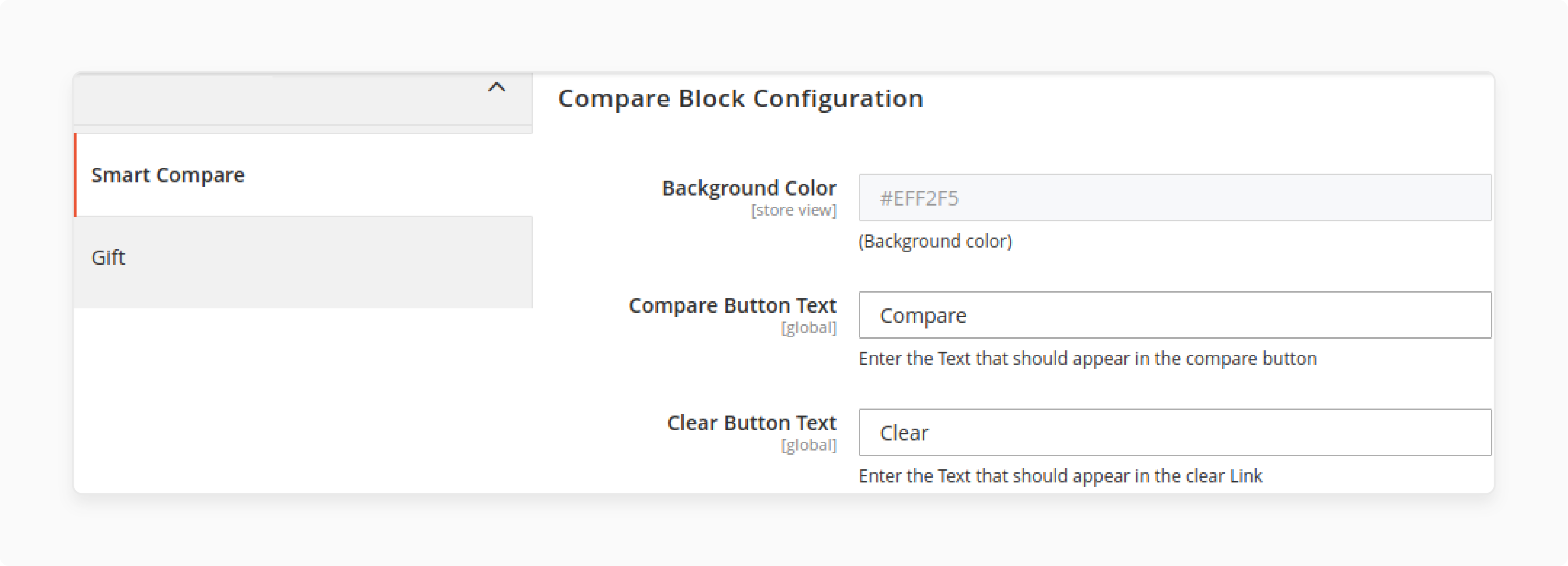
- Configure the background color of the compare tray. Set the ‘Compare’ and ‘Clear’ button texts.
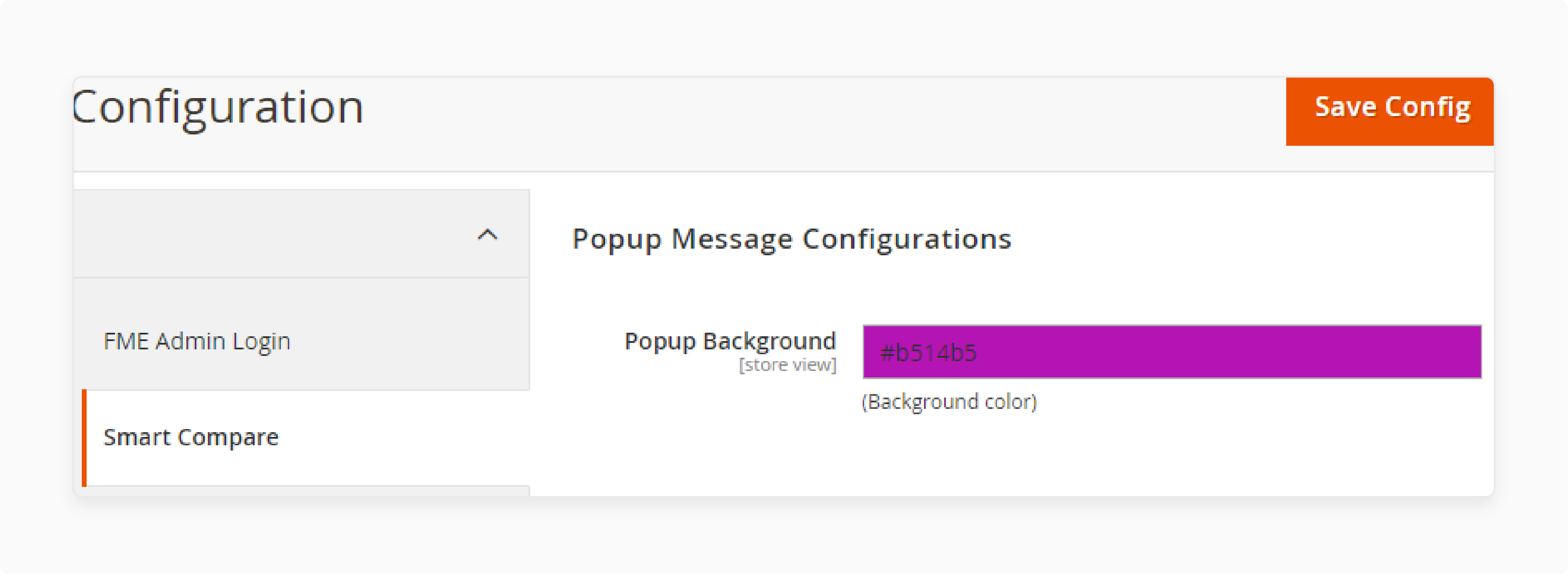


- Set the popup background color, text color, and the message to display. All these attributes will display when a customer exceeds the maximum limit.
3.2 Frontend Experience
- Category & Product Page
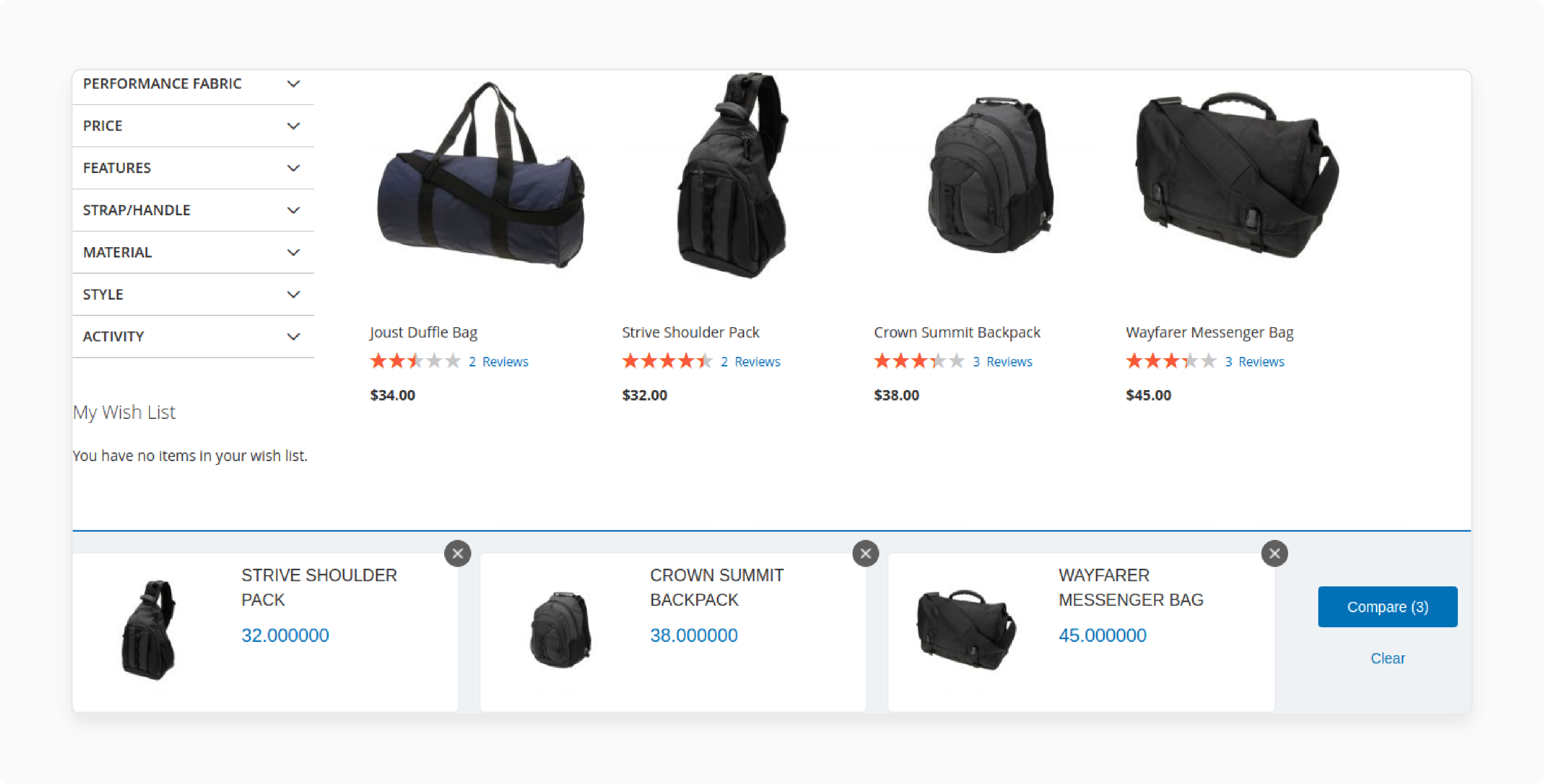
- Customers can select products from the pages and add them to the compare tray.
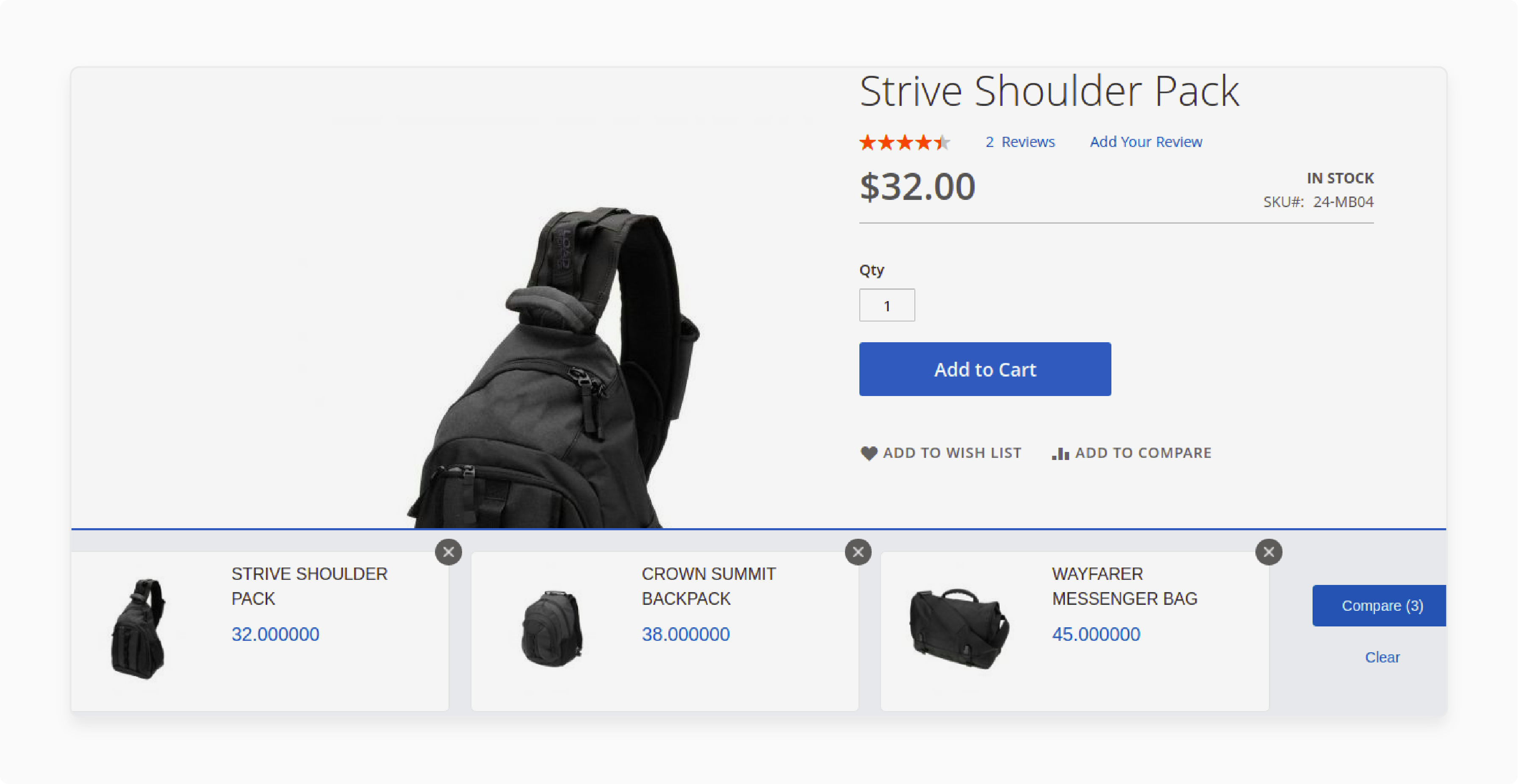
- The selected products will be displayed at the bottom of the page for easy comparison.
- Popup Message
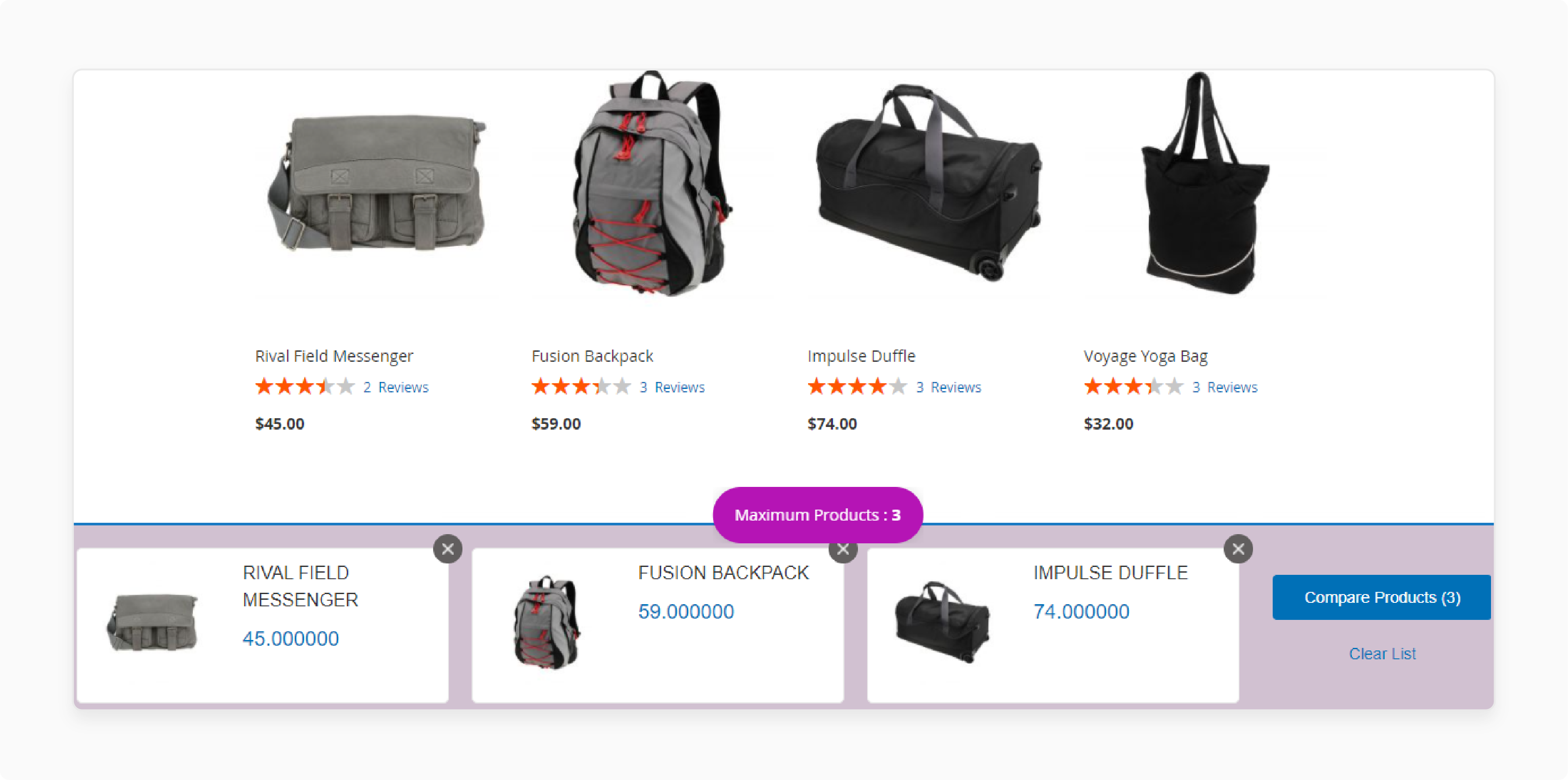
- Customers can add more products than the allowed limit. A popup message will appear with the configured text and colors.
Common Magento 2 Product Comparison Errors and Resolution Steps
1. Database Issues
| Error | Cause | Resolution |
|---|---|---|
| Missing Comparison Data | Corrupted catalog_compare_item table | sql ALTER TABLE catalog_compare_item AUTO_INCREMENT = 1; |
| Product Attribute Sync Failure | Incorrect EAV table entries | php bin/magento indexer:reindex catalog_product_attribute |
| Customer Session Loss | Invalid session table records | Clear var/session/* and verify session configuration |
2. Template Problems
| Error | Cause | Resolution |
|---|---|---|
| Layout XML Conflicts | Invalid handle in compare.xml | Review app/design/frontend/theme/layout/catalog_product_compare.xml |
| PHTML Template Errors | Missing block declarations | Check template path: catalog/product/compare/list.phtml |
| CSS Loading Issues | Incorrect asset deployment | Run php bin/magento setup:static-content:deploy |
3. API Integration Errors
| Error | Cause | Resolution |
|---|---|---|
| REST API 404 | Wrong endpoint configuration | Verify V1/products/comparison-list/ route |
| GraphQL Schema Issues | Missing compare fields | Add the compareList query to the schema.graphqls |
| Response Format Errors | Invalid JSON structure | Check response formatter in CompareListInterface |
FAQs
1. How do I set up magento 2 compare product features for my online shop?
The magento compare products feature comes automatically enabled in magento open source. Use the admin sidebar configuration to customize comparison methods. Add a compare button to your storefront. Set the minimum number of compared attributes. Configure the comparison chart and table template for your ecommerce website.
2. What are the best product comparison methods for customers to compare products?
Let customers view products side by side in the comparison table. Add essential features and characteristics of products to compare. Show product advantages clearly. Display online price, star rating at the bottom, and current product storage availability. Include related items and recently viewed products.
3. Can I disable compare products in magento 2?
Yes, you can disable magento 2 compare products through the admin panel. The comparison process cannot disable automatically. Using the admin sidebar configuration, turn off the compare products feature in magento. Remove the comparison list actions from your store.
4. How does the magento store handle recently compared products?
The sidebar shows recently compared products and allows customers to compare items easily. The comparison experience includes product recommendations and related products. The products block displays characteristics and features. The comparison report shows the best strengths and features.
5. What happens when products with the maximum limit are added to compare?
The magento compare products feature limits items to the comparison table. When customers reach the maximum, they see a notice. The comparison list shows products they are interested in comparing. Advanced compare options help find the product better than others.
6. How do Shopify product feed and default magento compare?
Default magento offers built-in comparison chart features. The comparison list actions work differently than the Shopify product feed. Magento store lets you configure product advantages. Low-priced products appear at the bottom of the comparison chart.
7. What determines the star rating at the bottom of product comparisons?
The star rating system plays an essential role in product comparison. Customer reviews determine the star rating. The comparison experience shows ratings for all products you sell. Visit our website section explains the rating calculation method.
Summary
Magento 2 product comparison helps customers make better buying choices. The table offers a lateral comparison of product features and pricing. Below mentioned are the article’s key highlights:
-
Mobile optimization keeps comparison features working on all devices. Responsive design adapts the comparison table to different screen sizes.
-
Regular cache clearing prevents most comparison display problems. Clear your store's cache after changing comparison settings.
-
Database maintenance keeps comparison features running smoothly. Monthly database checks stop data corruption issues.
-
Security measures protect comparison data from unauthorized access. Add CAPTCHA and rate limiting to prevent automated attacks.
-
Performance optimization makes product comparisons load faster. Limit the number of comparable products and attributes for speed.
Managed Magento hosting services offer error-free product comparison extension setup.




